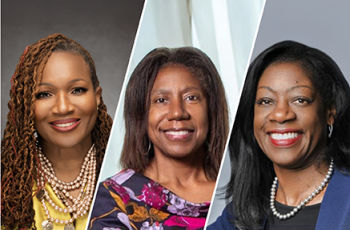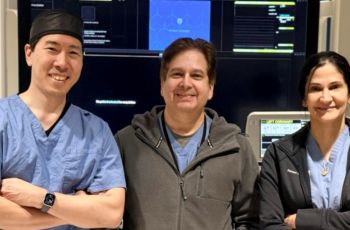In Hippocrates’ ancient Greece, uroscopy, the visual examination of a patient’s urine, was a common diagnostic practice. Dark urine was considered to indicate acute illness and light urine suggested chronic disease. Even until the 1800s, diabetes was diagnosed by tasting urine to determine if it was sweet. To the relief of lab technologists everywhere, the health sciences have progressed dramatically since that time.
This year marks the 70th anniversary of the Clinical Laboratory Science (CLS) program at GW’s School of Medicine and Health Sciences (SMHS). The program, directed by Sylvia Silver, D.A., Associate Dean for Health Sciences, and coordinated by Carol Smith, M.S., has undergone radical changes since its inception in 1942 as a part of the Columbian College of Arts and Sciences.
In the 1940s and ‘50s, Smith says, CLS used apprenticeship-style training and there was a very limited menu of tests that were performed in laboratories. By the ‘60s, labs became more automated, especially in chemistry. And in 1972, when CLS (then known as Medical Technology) moved to the newly formed SMHS, accreditation by outside organizations had begun to provide more structure from one program to the next.
Today’s CLS program, which is accredited by the National Accrediting Agency for Clinical Laboratory Sciences, offers two tracks: a bachelor of science in health science or a post-baccalaureate certificate in clinical laboratory science. It also offers four categorical certificate programs in blood banking, chemistry, hematology, and microbiology.
Silver, who has been at GW since 1978, says that clinical lab scientists are essentially detectives. They uncover information from laboratory analyses to assist physicians in patient diagnosis and treatment, as well as in disease monitoring and prevention. “If someone has had a heart attack,” Silver says, “we’re the ones who come up with the fact that it is a heart attack because the enzymes in the blood sample are skewed. We come up with the ‘why’ it is happening and the ‘what’ that is causing it,” she says.
Distance Education Model
As of 2002, CLS has moved to a distance education model that utilizes the web for lectures, assignments, and student interaction via discussion boards. After completion of their online courses, the students are required to undertake six months of practicums at a certified clinical site in their state of residence.
Smith, who is retiring in June after 31 years in the department, notes that distance education requires a lot of anticipation on the part of the professors. “It’s a different type of teaching in terms of the way you approach it,” she says. “You’re not seeing their faces, seeing the feedback that can make you say ‘Oh, they’re not getting that.’ And that’s where it comes in handy that Sylvia and I have both taught for so many years face-to-face. We know the types of things that normally create misunderstandings for the students and I keep that in the back of my mind when I’m preparing materials.”
One benefit of the distance education program, which offers a part-time schedule and tuition fees that are lower than those of on-campus programs, is that it provides an opportunity for working students who may not otherwise be able to pursue the degree.
Jessica Reinhardt, a 2006 graduate of the program who served in the military while pursuing her bachelor’s degree, is grateful for the flexibility offered by the distance education model. “It may have taken me nine years to get my degree,” Reinhardt says, “but if it wasn’t for GW and this model, I wouldn’t have been able to until much later. When I was activated by the military, Carol told me ‘Don’t worry, we’ll get through this. You will not sacrifice your education.’ And I didn’t.”
A partnership between GW and the U.S. Army and Navy that has been in place since the mid-1990s allows GW to award academic credit for the military’s medical laboratory technician programs to students like Reinhardt, who can then continue their education at GW. About a quarter of the students in the CLS program at any given time are from the military.
Strong Job Prospects
There is no shortage of jobs for newly minted lab technologists. Medical laboratory science is ranked third in job growth and job security among health professions. According to the Bureau of Labor Statistics, employment in the field is projected to increase by 14% through 2016. “Our graduates don’t have any trouble finding jobs,” Smith says. “Sometimes the clinical labs where they did their practicums will fight over them. One department wants to grab them before the other can,” she says. This is likely to remain the case for some time, as the average age of the clinical lab workforce is currently estimated to be over 50.
Reinhardt, who now works in biodefense for the U.S. Department of Homeland Security, has seen this need firsthand. “ Our field is always short of people and a program like this is instrumental in keeping us staffed with the people that we need to continue our important work,” she says. “I hope the program always continues to exist because we need to educate our young people so that they can fulfill the growing needs of the population.”
While most graduates of the program work in hospital labs or the clinics associated with them, others pursue advanced education. Medical and dental schools are frequent destinations, but former students have also gone on to public health school to study infectious diseases and business school to prepare for supervisory roles in the lab or health care administration positions. “It’s a marvelous stepping stone to future education and you can go in just about any direction,” Smith says.
The Human Element
Smith recalls a time when the field was just beginning to automate. “On some of the oldest instrumentation it was a big thing to be able to do 12 assays on a chemistry analyzer at one time. Now you’ve got analyzers where you can swap out reagent systems and do 20 to 30 at a time. They’re computer driven and some have walk-away modes. So automation has expanded exponentially the number of tests that are done in clinical laboratories,” she says.
Despite the dramatic changes in the field over the decades, the role of the clinical lab scientist has not been diminished. “It’s the old garbage in, garbage out theory,” Smith says. “You always have to have someone qualified to keep an eye on the results. Someone who says ‘Does this look right?’ and decides what to do next.”


